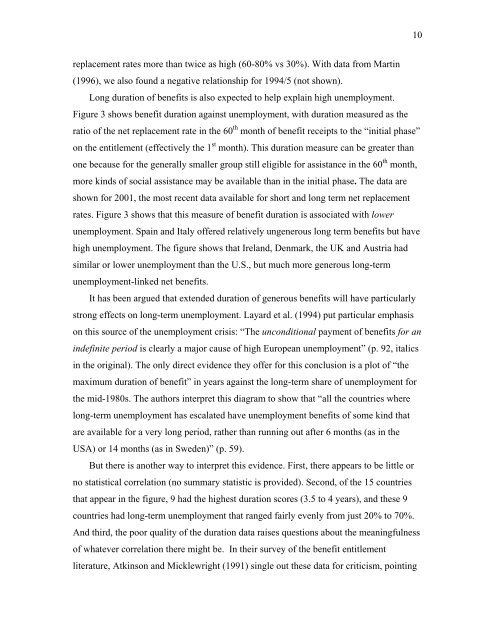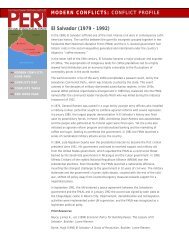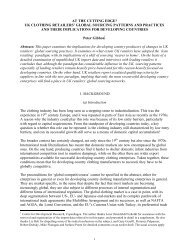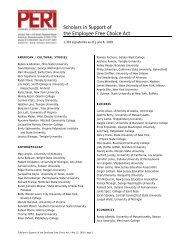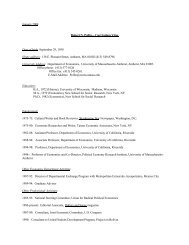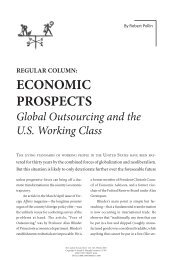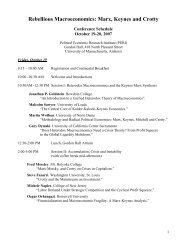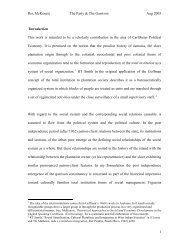Are Labor Market Institutions Really at the Root of Unemployment ...
Are Labor Market Institutions Really at the Root of Unemployment ...
Are Labor Market Institutions Really at the Root of Unemployment ...
Create successful ePaper yourself
Turn your PDF publications into a flip-book with our unique Google optimized e-Paper software.
10<br />
replacement r<strong>at</strong>es more than twice as high (60-80% vs 30%). With d<strong>at</strong>a from Martin<br />
(1996), we also found a neg<strong>at</strong>ive rel<strong>at</strong>ionship for 1994/5 (not shown).<br />
Long dur<strong>at</strong>ion <strong>of</strong> benefits is also expected to help explain high unemployment.<br />
Figure 3 shows benefit dur<strong>at</strong>ion against unemployment, with dur<strong>at</strong>ion measured as <strong>the</strong><br />
r<strong>at</strong>io <strong>of</strong> <strong>the</strong> net replacement r<strong>at</strong>e in <strong>the</strong> 60 th month <strong>of</strong> benefit receipts to <strong>the</strong> “initial phase”<br />
on <strong>the</strong> entitlement (effectively <strong>the</strong> 1 st month). This dur<strong>at</strong>ion measure can be gre<strong>at</strong>er than<br />
one because for <strong>the</strong> generally smaller group still eligible for assistance in <strong>the</strong> 60 th month,<br />
more kinds <strong>of</strong> social assistance may be available than in <strong>the</strong> initial phase. The d<strong>at</strong>a are<br />
shown for 2001, <strong>the</strong> most recent d<strong>at</strong>a available for short and long term net replacement<br />
r<strong>at</strong>es. Figure 3 shows th<strong>at</strong> this measure <strong>of</strong> benefit dur<strong>at</strong>ion is associ<strong>at</strong>ed with lower<br />
unemployment. Spain and Italy <strong>of</strong>fered rel<strong>at</strong>ively ungenerous long term benefits but have<br />
high unemployment. The figure shows th<strong>at</strong> Ireland, Denmark, <strong>the</strong> UK and Austria had<br />
similar or lower unemployment than <strong>the</strong> U.S., but much more generous long-term<br />
unemployment-linked net benefits.<br />
It has been argued th<strong>at</strong> extended dur<strong>at</strong>ion <strong>of</strong> generous benefits will have particularly<br />
strong effects on long-term unemployment. Layard et al. (1994) put particular emphasis<br />
on this source <strong>of</strong> <strong>the</strong> unemployment crisis: “The unconditional payment <strong>of</strong> benefits for an<br />
indefinite period is clearly a major cause <strong>of</strong> high European unemployment” (p. 92, italics<br />
in <strong>the</strong> original). The only direct evidence <strong>the</strong>y <strong>of</strong>fer for this conclusion is a plot <strong>of</strong> “<strong>the</strong><br />
maximum dur<strong>at</strong>ion <strong>of</strong> benefit” in years against <strong>the</strong> long-term share <strong>of</strong> unemployment for<br />
<strong>the</strong> mid-1980s. The authors interpret this diagram to show th<strong>at</strong> “all <strong>the</strong> countries where<br />
long-term unemployment has escal<strong>at</strong>ed have unemployment benefits <strong>of</strong> some kind th<strong>at</strong><br />
are available for a very long period, r<strong>at</strong>her than running out after 6 months (as in <strong>the</strong><br />
USA) or 14 months (as in Sweden)” (p. 59).<br />
But <strong>the</strong>re is ano<strong>the</strong>r way to interpret this evidence. First, <strong>the</strong>re appears to be little or<br />
no st<strong>at</strong>istical correl<strong>at</strong>ion (no summary st<strong>at</strong>istic is provided). Second, <strong>of</strong> <strong>the</strong> 15 countries<br />
th<strong>at</strong> appear in <strong>the</strong> figure, 9 had <strong>the</strong> highest dur<strong>at</strong>ion scores (3.5 to 4 years), and <strong>the</strong>se 9<br />
countries had long-term unemployment th<strong>at</strong> ranged fairly evenly from just 20% to 70%.<br />
And third, <strong>the</strong> poor quality <strong>of</strong> <strong>the</strong> dur<strong>at</strong>ion d<strong>at</strong>a raises questions about <strong>the</strong> meaningfulness<br />
<strong>of</strong> wh<strong>at</strong>ever correl<strong>at</strong>ion <strong>the</strong>re might be. In <strong>the</strong>ir survey <strong>of</strong> <strong>the</strong> benefit entitlement<br />
liter<strong>at</strong>ure, Atkinson and Micklewright (1991) single out <strong>the</strong>se d<strong>at</strong>a for criticism, pointing


